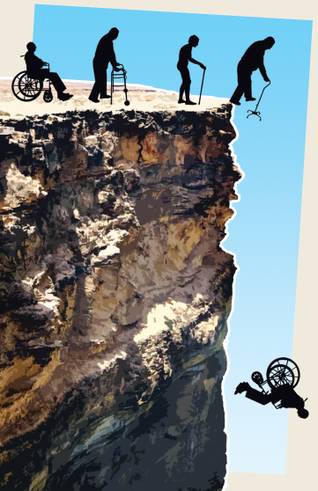Tuesday, Feb. 2, 2010 | 4:15 p.m.
Suicide statistics are a grim science, one that dresses data in careful terms, like "attempt-to-completion ratio." That's the number of attempted suicides compared to the number of successful suicides.
Or, more casually, the number of nightmares to horrors. Sometimes it's the coldest calculations that best reveal our most complicated human conditions.
Consider the suicide attempt-to-completion ratio for people 25 and under: For every completed suicide in that group, statistics suggest there are 100-200 attempts. (Not per person, but group-wide.) While many young people may attempt suicide, comparatively few actually kill themselves.
Now consider the ratio for people 65 and older: It's 4:1. Statistically, for every four older adults who attempt suicide, one will die.
That difference between age groups says something significant. Something Jerry Reed, director of the Suicide Prevention and Resource Center in Washington, D.C., summed up neatly during a recent seminar on geriatric suicide at UNLV:
"Older adults are more intent to end their lives when they make that decision."
Now weigh that fact against these statistics: Studies show that almost 60 percent of senior citizens who commit suicide saw their doctor within a month of their death, a quarter told someone they planned to commit suicide, and more than 20 percent experienced a traumatic event just two weeks before they took their own lives.
In most cases, Reed said, "There were signs. I guess that was the bottom line." And where there are signs, there's the possibility of prevention.
Geriatric suicide is another one of those miserable issues that Nevada leads the nation in. The most recent numbers show Nevadans over 60 have the nation's highest suicide rate. (For suicide across all age groups, Nevada is listed second in the country, after Alaska.)
Researchers have pinpointed the things that often lead to depression in seniors. Most are side effects of aging: isolation, bereavement, reduced ability, illness, pain. In one study, almost half of the seniors living in long-term care facilities reported serious depression.
Moreover, suicide attempts in late life are often more lethal: Elderly people are frail, and more likely to die. They are more isolated, and less likely to be rescued. Moreover, as Reed noted, they're more "planful and determined." When they make the decision, they commit.
Reed studied states with the highest geriatric suicide rates—Nevada, Wyoming, Idaho and Oregon are the top four—and found three things in common: high divorce rates, high gun ownership and few people per square mile. Isolation, access and isolation.
Of course, elderly suicide has implications beyond Nevada—it's predicted that by 2050, 22 percent of the world's population will be over 60. That's up double from 2007. What's also significant is that small interventions have been shown to greatly reduce senior suicide rates. One research project, in Italy, found that simply calling seniors on the phone and addressing their isolation reduced the predicted suicide rate by 70 percent. Another study found that mandatory waiting periods when purchasing firearms (guns are the most popular method of suicide for Nevada's aged, followed by poison) also reduced the senior suicide rate.
These are small things. Little changes with big impact. And perhaps that's what makes the high senior suicide rate so troubling to people like Reed.
"Is it a brighter tomorrow? Are you looking forward to next week?" he said. "These are things that really matter."


Join the Discussion:
Check this out for a full explanation of our conversion to the LiveFyre commenting system and instructions on how to sign up for an account.
Full comments policy